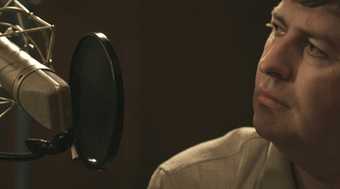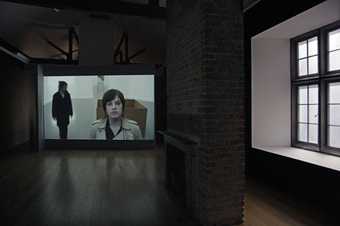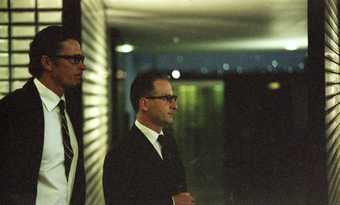Tate Etc.
Your new work, A Thing Is A Hole In A Thing It Is Not, made jointly for Lismore Castle Arts and the Glasgow International Festival Co-commission of Glasgow International, Renaissance Society, Van Abbemuseum, and Lismore Castle Arts, is a four screen film installation. Can you start by briefly describing each film?
Gerard Byrne
The first film one encounters relates to the Robert Morris work Column from 1960, a performance piece using a plywood column. The Morris performance began with the column upright on stage for three and a half minutes, then toppling over and lying on its side for another three and a half minutes. Column is interesting because of the way it so clearly exemplifies the temporal character of Minimalism.
The adjacent film is based on a radio interview from 1964 between Bruce Glaser, Frank Stella, Donald Judd and Dan Flavin. (That interview has subsequently been transcribed and edited by Lucy Lippard and widely published as part of the literature on minimalism. In the published interview, Dan Flavin is edited out of it). The film uses the original audio recording edited together with visuals from a similar scenario I staged in a period radio studio with actors 36 years later. At times it seems as if the video and audio are synched, at least in the minds eye.

Gerard Byrne
A Thing Is A Hole In A Thing It Is Not 2010
Production still
Co-commissioned by Lismore Castle Arts, 2010 Glasgow International Festival Of Visual Art and The Renaissance Society at the University of Chicago in collaboration with the Van Abbemuseum, Eindhoven © Gerard Byrne
The third film is a series of vignettes that were filmed in the Van Abbemuseum using Minimalist works from the collection that I wanted to reference. We worked with a mix of actors and non actors, including a museum photographer, cleaners, security staff, and visitors. Ostensibly the film appears to be about how the works cohabit in a museum space with the other comings and goings of the museum, but ultimately there’s a particular stylisation in terms of how it’s shot. There’s a lot of point of view (PoV) shots, for example. I’m very interested in this idea of how you would construct – in a filmic way - what the experience of encountering a Minimalist work might be like.

Gerard Byrne
A Thing Is A Hole In A Thing It Is Not 2010
Installation view
Co-commissioned by Lismore Castle Arts, 2010 Glasgow International Festival of Visual Art and The Renaissance Society at the University of Chicago in collaboration with the Van Abbemuseum, Eindhoven © Gerard Byrne
The final film is a very straight reconstruction based on the anecdote from the sculptor Tony Smith where he talks about this road-to-Damascus type of experience he had while driving on the New Jersey Turnpike in the early 1950’s that led him towards Minimalism.

Gerard Byrne
A Thing Is A Hole In A Thing It Is Not 2010
Production still
Co-commissioned by Lismore Castle Arts, 2010 Glasgow International Festival of Visual Art and The Renaissance Society at the University of Chicago in collaboration with the Van Abbemuseum, Eindhoven © Gerard Byrne
Tate Etc.
For the viewer, the narratives are often fragmented. There is no clear structure, so you need to spend a while building up a sense of what you see. However, each section is directly referential to art – and in particular Minimalism. Why did you choose this subject?
Gerard Byrne
I’ve always been interested in the Michael Fried essay ‘Art and Objecthood’ which took Minimalism as its object of critical focus. It has invariably been relevant to the different projects I’ve done before, albeit never blatantly. For me what really matters in the Fried text is the way that it articulates a transitional moment in contemporary art towards an awareness that art is increasingly grounded in temporality. Whereas, the irony of modernism (e.g. the work of Henry Moore/Jackson Pollock) is that it seems contingent on an idea of time that’s somehow held in abeyance, or that’s somehow frozen…as if sometimes to transcend temporality is to actually be fully modernist. I’ve always been interested in Modernisms fetishisation of the primeval, as embodied in the sculpture of Moore for example with its connections to the Venus of Willendorff. It seems that late Modernism involved a certain idealisation of time, whereas Minimalism dwelled in the endless durationality of time.
That’s also part of the rationale for why I’m interested in making video based work which is shown in a gallery space as opposed to in a cinema or on a TV. Showing video in a gallery space involves a double temporality – the temporality that’s constructed alongside the temporal experience of you walking into the space, experiencing it, and then deciding to walk away from it.
Tate Etc.
At the same time you seem to enjoy with playing with the history of these ideas and the medium within that, particularly those certain mythologies that are attached to Minimalism.
Gerard Byrne
Well I’ve always been interested in the paradoxical quality of an artistic moment where the works might be characterised by their stoicism, and the language that was used to mediate that work, to reconcile it socially and politically.
Tate Etc.
Is it partly about putting a, kind of, part of human interest, as in, putting a bit of life back into works that have been dehumanised?
Gerard Byrne
Well, yes, but I wouldn’t see my project as being a rehabilitation. Minimalism is healthy enough on its own. For example the radio interview is so very close to what you’re talking about because you have these artists having this wonderfully abstract conversation about very formalist qualities. I enjoy the fact that this was broadcast on public radio; the contradiction of this very ethereal immaterial broadcast about a very materialist, sensibility – dripping paint, shapes, forms, colour and so on.
Tate Etc.
That conversation links into what happens in the next film, where you see the Minimalist works by artists that are mentioned in the radio talk, filmed in the Van Abbemuseum….
Gerard Byrne
Yes. On a very basic level in that particular section I think it’s clear that the project enters into a conversation with the arguments that Fried made, but in a purely filmic way.
Tate Etc.
Did you use actors?
Gerard Byrne
There is some acting amongst what is filmed. Some people are very self consciously aware of being filmed, and you can see that. In previous works I’ve worked a lot with actors. I’ve been quite interested in this idea that there is a grey area between acting and non acting. And I wanted to have something where the works didn’t seem to be at odds with what was happening around them.
Tate Etc.
The sense of the artificial seems very important in this work.
Gerard Byrne
Yes, absolutely. There are certain very subtle parts in the museum sections which I think are quite telling. For example, there’s a whole bit where the museum photographer is shooting the Minimalist works and you have these strange PoV shots from the camera and from the work. What I was interested in is the idea of how these three dimensional things are rendered into 2D imagery, and how contrived the constructed image is. A relativity of relations between subject and object feeling conspicuous. There is also a hermetic quality to the museum space. It is almost like a laboratory where controlled experiments with subjectivity and Art history can be tested.
Tate Etc.
In terms of how you construct the film, the sense of narrative is intended to be left open…
Gerard Byrne
I always work with open ended formats. That is partly because I am interested in making media-based works that are formally difficult to quantify. I am interested in that formal paradox. Most video works I make are actually relatively long, and I purposely do that because I like the idea of people giving up at a certain point. I like that slightly doubtful type relationship between a work and its audience. Also it makes sense in terms of the nature of this project – which relates to Fried’s conception of endlessness in art. The installation format was important in this respect too. I designed the surfaces onto which the images are projected in such a way that they’re all free-standing; none of them actually touch the walls of the gallery. It was very important to me that you could walk around them.

Gerard Byrne
1984 and Beyond 2005
3 single channel DVDs
Production still
Courtesy Lisson Gallery, London © Gerard Byrne
Tate Etc.
The works that is now on at Tate Britain, and previously premiered at the Venice Biennale, called 1984 and Beyond seems, on the surface, a quite different kind of work. It is based on this text that was published in Playboy in 1963 and is a reconstruction of a round table conversation between a group of American-based science fiction writers, who talk about what the world would be like in 1984. How did this piece come about?
Gerard Byrne
When I originally developed the idea for A Thing Is A Hole In A Thing It Is Not 2010 work, I was in production with1984 and Beyond, so there’s a strange temporal correspondence between the two. Again, for me, it was a way of somehow testing the text in front of a camera, which is also partially in the project of A Thing Is A Hole In A Thing It Is Not as well.

Gerard Byrne
1984 and Beyond 2005
3 single channel DVDs
Production still
Courtesy Lisson Gallery, London © Gerard Byrne
Tate Etc.
Why did you choose this Playboy conversation?
Gerard Byrne
Over the last ten years or so I’ve made a number of works that have used text from magazines as source material. For me working with magazines has been a way to work is larger issues to do with how time is constructed as a coherent experience through the media industry. Initially I was interested in magazines as a barometer of a certain cultural moment. Magazines seem to be absolutely of the moment, and at the same time they are the first thing that’s discarded. They have a very particular kind of character on that level. I’ve always been fascinated by the way magazines try to pick up on something much more unquantifiable; they’re not burdened with reporting the facts of the situation but have always attempted to concretise and mainstream the particular – whether it be current affairs, hot rods, teenage girls, or esoterica. By re-reading these magazines from the recent past, there was a way of somehow unlocking other ideas of the present – of rethinking the present and how we’ve got there. So, if we’re looking at something from twenty years ago it becomes palpable that certain things that have happened subsequently were unclear or could have gone differently …I’m sounding very Proustian…
Tate Etc.
But this has nothing to do with nostalgia, does it…
Gerard Byrne
No. Nostalgia is something that I really try to avoid in my own approach. (I think in a lot of the recent art that is engaged with the recent past feels nostalgic and really wallows in a certain kind of retro chic). I’m much more interested in the Walter Benjamin notion of idea of looking at the recent past and realising how, at that moment, the present that we live in was not inevitable. 1984 and Beyond is actually the most legible example of that because when you listen to these science fiction writers talking, you realise how different the world we live in is to the world they speculated on. Above all the past and the future as both fantastical projections of an unrepresented and constantly shifting present is a central quality of that work.
